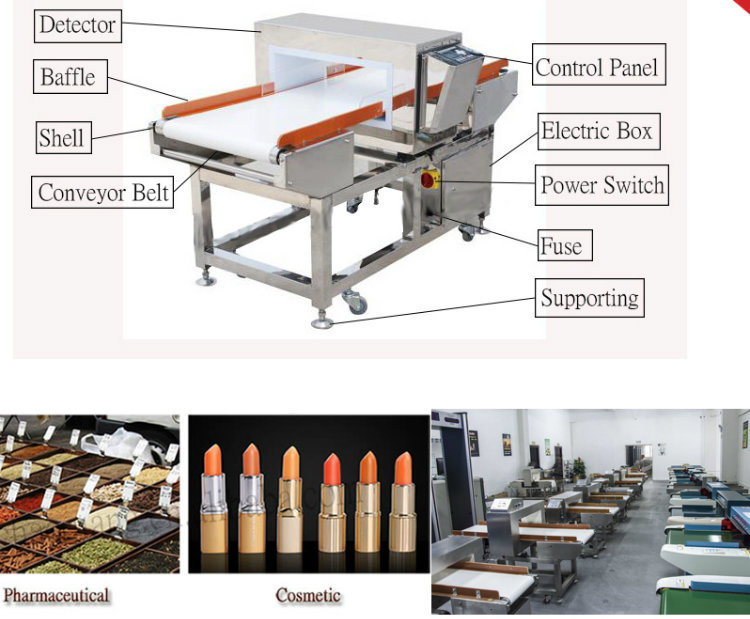Â
Features: |
- Made of 304 stainless steel, durable and nice appearance, conveyor and pallet assembly used in white non-toxic materials.
- Digital machine, memory function for registering various products(Max: over 12 items).
- Adopt the combine technology of double signal and detection circuit, LCD display, with Chinese and English menu, easy operation.
- Adopt Germany professional detection technology with balanced principle, more reliable, better performance. Dual-channel and frequency detecting ferrous, non-ferrous and stainless steel.
- DSP and MCU combination of the detection signal for data sampling and data processing, improve the detection results.
- A new circuit design, high sensitivity, mature phase adjustment technology, can adjust the products automatically, inhibit the products effect effectively.
- Able to detect iron, stainless steel, copper, aluminum and other non-ferrous metals and other materials.
- With the learning function of automatic identification, overcome the effect of products materials efficiently, strong anti-interference and shock proof.
- Support 24 hours non-stop working.
- fairly good waterproof ability, apply to high temperature, low temperature, damp, dry, dust, dew and other poor work environment.
Application: |
Mainly used in food, aquatic products, toys, clothing, footwear, chemicals, leather, knitting and other industries, for the detection of inclusions or lost in the raw materials or products broken needle, wire and other metals, preventing metal pollution of the products and guaranteeing product quality. Be able to detect various metals like iron, stainless steel, copper and aluminum, etc.
Â
Technical parameters: |
| Type | Standard | Non-standard | |||||||
| Detection Width(mm) | 300-450 | 500(Customized) | |||||||
| Detection Height(mm) | 100 | 120 | 150 | 200 | 250 | 300 | 350 | 400 | |
| Sensitivity | Fe(mm) | 0.6-0.8 | 0.8-1.0 | 1.0-1.2 | 1.5 | 2.0 | 2.5 | 3.0 | 3.0 |
| SUS(mm) | 1.2 | 1.5 | 2.0 | 2.5 | 3.0 | 3.5 | 4.0 | 4.5 | |
| Non-ferrous(mm) | 1.2 | 1.5 | 2.0 | 2.5 | 3.0 | 3.5 | 4.0 | 4.5 | |
| Alarm Method | Audible and visual alarm, stop automatically | ||||||||
| Material | Full 304 stainless steel | ||||||||
| Dimension | 1600x840x1005 | ||||||||
| Weight | About 250kg | ||||||||
| Power | 220v 50Hz, 120W | ||||||||
| Load Capacity | 5-25kg, transfer speed: 24-30M/min | ||||||||
| Remarks | Above parameters come from experimental values of the standard state, the concrete sensitivity would be affected according to the products being detected, working condition and also the different positions the metal mixed with. | ||||||||



 Food Security Detection Conveyor Belt Metal Detector Machine SA810
Â
Features: |
- Made of 304 stainless steel, durable and nice appearance, conveyor and pallet assembly used in white non-toxic materials.
- Digital machine, memory function for registering various products(Max: over 12 items).
- Adopt the combine technology of double signal and detection circuit, LCD display, with Chinese and English menu, easy operation.
- Adopt Germany professional detection technology with balanced principle, more reliable, better performance. Dual-channel and frequency detecting ferrous, non-ferrous and stainless steel.
- DSP and MCU combination of the detection signal for data sampling and data processing, improve the detection results.
- A new circuit design, high sensitivity, mature phase adjustment technology, can adjust the products automatically, inhibit the products effect effectively.
- Able to detect iron, stainless steel, copper, aluminum and other non-ferrous metals and other materials.
- With the learning function of automatic identification, overcome the effect of products materials efficiently, strong anti-interference and shock proof.
- Support 24 hours non-stop working.
- fairly good waterproof ability, apply to high temperature, low temperature, damp, dry, dust, dew and other poor work environment.
Application: |
Mainly used in food, aquatic products, toys, clothing, footwear, chemicals, leather, knitting and other industries, for the detection of inclusions or lost in the raw materials or products broken needle, wire and other metals, preventing metal pollution of the products and guaranteeing product quality. Be able to detect various metals like iron, stainless steel, copper and aluminum, etc.
Â
Technical parameters: |
| Type | Standard | Non-standard | |||||||
| Detection Width(mm) | 300-450 | 500(Customized) | |||||||
| Detection Height(mm) | 100 | 120 | 150 | 200 | 250 | 300 | 350 | 400 | |
| Sensitivity | Fe(mm) | 0.6-0.8 | 0.8-1.0 | 1.0-1.2 | 1.5 | 2.0 | 2.5 | 3.0 | 3.0 |
| SUS(mm) | 1.2 | 1.5 | 2.0 | 2.5 | 3.0 | 3.5 | 4.0 | 4.5 | |
| Non-ferrous(mm) | 1.2 | 1.5 | 2.0 | 2.5 | 3.0 | 3.5 | 4.0 | 4.5 | |
| Alarm Method | Audible and visual alarm, stop automatically | ||||||||
| Material | Full 304 stainless steel | ||||||||
| Dimension | 1600x840x1005 | ||||||||
| Weight | About 250kg | ||||||||
| Power | 220v 50Hz, 120W | ||||||||
| Load Capacity | 5-25kg, transfer speed: 24-30M/min | ||||||||
| Remarks | Above parameters come from experimental values of the standard state, the concrete sensitivity would be affected according to the products being detected, working condition and also the different positions the metal mixed with. | ||||||||



Â
DETAILED DESCRIPTION
Rotary Dryer, also known as rotary drum dryer,rotary drier.
According to different ways of heating raw material,the rotary dryer can be divided into direct heating-type rotary dryer and indirect heating-type rotary dryer. The rotary dryer can be classified into Coal Slime Rotary Dryer, Sawdust Dryer, Coconut shell dryer, slag rotary dryer and clay rotary dryer according to different raw materials.According to different structure, the rotary dryer can be divided into Three cylinder dryer, Double-drum Dryer.
Being widely used in building materials, metallurgy, chemicals, industrial drying slag cement limestone, coal, slag, clay and other materials.
The aircraft is mainly composed of the rotary, jan plate, transmission, seals, and other support equipment and components.
Being featured with a reasonable structure, well-produced, high yield, low consumption and operating convenience.
Offering products quality assurance, and highest free installation debugging agent can be checked with other plants than quality and prices.
How to improve rotary dryer`s efficiency
1. Improving temperature of drying medium of rotary dryer.
2. Improving flow rate of drying medium.
3. Improving internal structure of cylinder body of rotary dryer, adopting combined raise material.
4. Reducing material feeding granularity
5. Using concurrent processing set-up where possible
6. Adopting step-less speed regulator
Specifications of Rotary dryer
1. Standard testing
2. High process speed
3. Stable working conditions
4. ISO9000 and BV
Working principle of Rotary dryer

When rotary Dryer is operating, it shall be in direct contact with heated gas. The dryer consists of a large rotating cylindrical tube. In order to convey the material through the underside of dryer, the dryer should be slanted slightly to ensure that the discharge end is lower than the end of material feed .
Working Principle of Rotary Dryer: Material shall be dried to enter the dryer. When the dryer is rotating, a series of internal fins will lift the material by lining the inner wall of the dryer. When the material reaches certain height to roll the fins back, it will be fell back to the bottom of the dryer, then passing through the hot gas stream as it falls. This gas stream can either move toward the discharge end from the feed end (known as co-current flow), or toward the feed end from the discharge end (known as counter-current flow). The gas stream can be composed of a mixture of air and combustion gases from a burner, and in which case the dryer is known as a direct heated dryer. Alternatively, the gas stream may be made up of air or another (sometimes inert) gas that is preheated. When the gas stream is preheated by some means where burner combustion gases are not permitted to enter the dryer, the dryer shall be called an indirect-heated type. Indirect heated dryers are commonly used when product contamination becomes a concern. Read How Does HONGKE Rotary Dryer Work?
Rotary Dryer
Rotary Dryer,Manure Rotary Dryer,Rotary Dryer Machine,Wood Sawdust Rotary Dryer
Henan Hongke Heavy Machinery Co., Ltd. , http://www.rotarykilnchina.com